Never Fall Behind With These 8 Easy to Practice Time Management Techniques

We all procrastinate, albeit with guilt and consequences. Procrastination is natural so take it easy and don’t be so hard on yourself. What you can however do is to learn to keep procrastination at its minimum by with some of the proven time management techniques from around the world that are listed and described below. These techniques will not only help you to utilized time better but also let you prioritize task so you don’t miss out on urgent and important tasks. Let’s take a deep dive in into the realm of time management.
Time Management Techniques
Here is a selection of 8 meticulously chosen time management strategies, complete with descriptions and instructions on their application.
1. Eat That Frog

Among the meticulously chosen time management strategies, “Eat That Frog” stands out as a powerful technique. It emphasizes the importance of tackling the most challenging and significant task first thing in the morning, akin to “eating a frog.” The premise is that by completing the most daunting task early, you not only achieve a major accomplishment but also gain momentum and confidence to handle other tasks throughout the day. This approach encourages prioritizing tasks based on their impact and urgency, leading to more productive and efficient time management.
To effectively adopt the “Eat That Frog” technique, follow these step-by-step instructions:
- Identify Your Frog: Start by identifying the most challenging or important task you have for the day. This is your “frog” – the task you’re likely to procrastinate on if you don’t tackle it first.
- Prioritize Your Tasks: Arrange your tasks in order of importance and urgency. Ensure your frog is at the top of this list.
- Plan Your Day the Night Before: Before you finish work for the day, make a list of what needs to be done the following day. Knowing your priorities ahead of time helps you start your day with a clear focus.
- Tackle Your Frog First Thing in the Morning: Begin your day by working on your most significant task. Avoid checking emails or engaging in other activities that can distract you until after your frog is eaten.
- Apply the 80/20 Rule: Understand that 20% of your tasks will contribute to 80% of your results. Your frog is part of that crucial 20%; focus on tasks that have the greatest impact.
- Limit Distractions: Create a work environment that minimizes interruptions and distractions. This might mean turning off notifications, finding a quiet space, or using tools that block distracting websites.
- Commit to the Task: Give your full attention and effort to completing your frog. Avoid multitasking, as it can dilute your focus and extend the time needed to finish your task.
- Celebrate Your Achievement: Once you’ve completed your frog, take a moment to acknowledge your accomplishment. This positive reinforcement will motivate you for the next day.
By following these steps, you’ll be able to effectively implement the “Eat That Frog” technique, leading to improved productivity and time management.
2. Pomodoro Technique
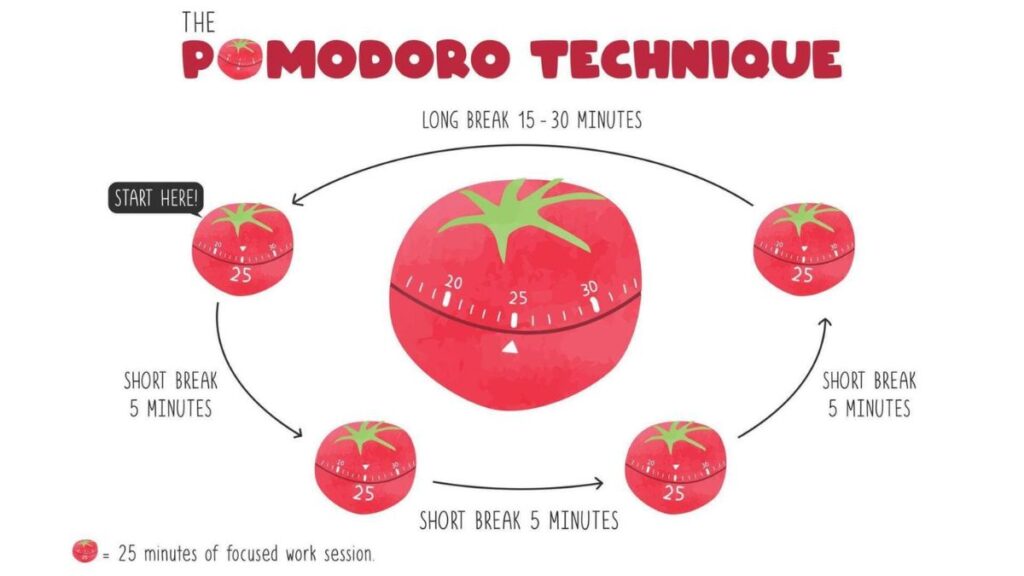
The Pomodoro Technique is another effective time management method included in our selection of meticulously chosen strategies. This approach involves breaking down work into short, timed intervals, traditionally 25 minutes in length, known as “Pomodoros,” followed by a short break. This cycle is repeated throughout the day. It is particularly beneficial for maintaining focus and motivation, preventing burnout, and managing the cognitive load by alternating work periods with rest.
To adopt the Pomodoro Technique, follow these step-by-step instructions:
- Choose a Task: Pick a task you want to work on. It can be anything, from a small task to a portion of a larger project.
- Set a Timer for 25 Minutes: Use a timer to count down from 25 minutes. This marks your work period, during which you should focus solely on the task at hand.
- Work on Your Task Until the Timer Rings: Give your full attention to the task, avoiding any distractions. If you suddenly remember another task, jot it down to do later, and continue with your current task.
- Take a Short Break (5 minutes): Once the timer goes off, stop working and take a short break. This is the time to step away from your work, stretch, grab a cup of coffee, or do something else relaxing.
- Repeat the Process: After your break, reset the timer for another 25 minutes and start working on a task. Continue this cycle through your workday.
- Take a Longer Break After Four Pomodoros: After completing four Pomodoro sessions, take a longer break, about 15 to 30 minutes. This helps to recharge your energy for the next set of Pomodoros.
- Adjust the Timing if Necessary: While the traditional Pomodoro is 25 minutes of work followed by a 5-minute break, feel free to adjust these timings based on what works best for you. The key is to maintain a rhythm of focused work sessions followed by rest.
- Track Your Progress: Keep a log of how many Pomodoros it takes to complete tasks. This can help with planning and estimating future tasks more accurately.
By incorporating the Pomodoro Technique into your daily routine, you can enhance your productivity, manage your time more effectively, and maintain a healthy balance between work and rest.
3. 2-Minute Rule
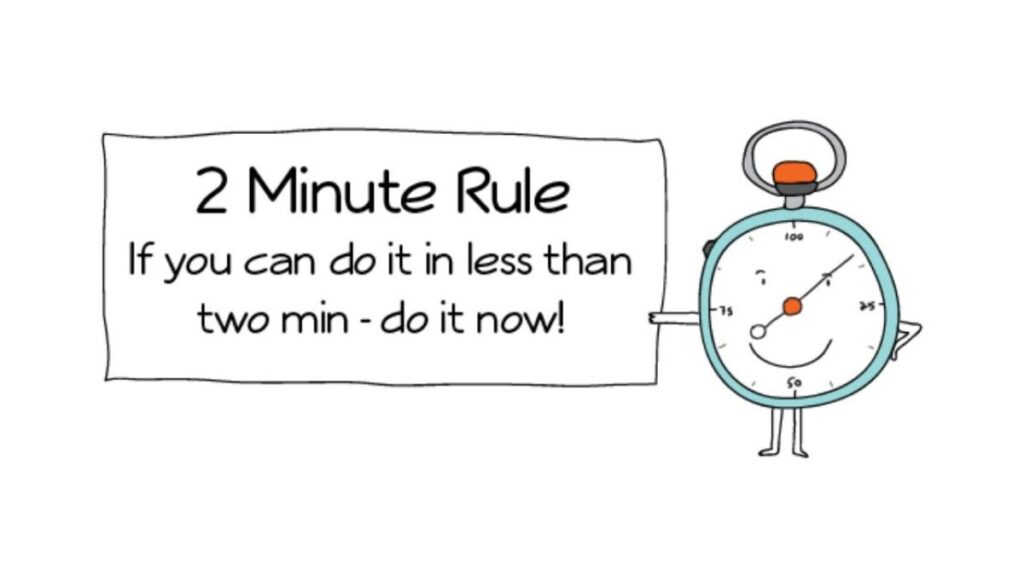
The 2-Minute Rule is an efficient time management strategy that emphasizes the power of starting small to overcome procrastination. This technique, from our curated selection, advocates for taking immediate action on tasks that can be completed in two minutes or less. The underlying principle is that the act of starting is often the most challenging part of any task. By committing to just two minutes, you can make significant progress on your to-do list and build momentum for tackling larger projects.
To implement the 2-Minute Rule, follow these steps:
- Evaluate Your Task List: Go through your list of tasks and identify any that can realistically be completed in two minutes or less. These can range from sending a quick email to filing a document.
- Do It Immediately: If a task takes two minutes or less to complete, do it right away. The goal is to prevent small tasks from accumulating and taking up mental space, thereby reducing clutter and stress.
- Apply the Rule to Larger Tasks: For more substantial tasks or projects, find a component of the work that can be completed within two minutes. This might be writing the first sentence of a report or setting up your workspace. The idea is to break down larger tasks into manageable actions.
- Use It to Overcome Procrastination: Whenever you find yourself procrastinating, ask if there’s a part of the task that can be done in two minutes. Starting with a small, easy-to-complete action can help overcome inertia and propel you into further action.
- Incorporate It into Your Daily Routine: Make the 2-Minute Rule a habit by consistently applying it throughout your day. You’ll find that it not only helps with productivity but also keeps your work environment and schedule more organized.
- Expand the Principle: Once you’ve mastered starting tasks with the 2-Minute Rule, consider extending the principle to longer periods for more significant tasks. The key is building the habit of starting immediately.
- Reflect on Your Progress: Regularly review the tasks you’ve completed using the 2-Minute Rule. This reflection can provide insights into how you spend your time and motivate you to continue applying the rule.
By adopting the 2-Minute Rule, you’ll find that many tasks are less daunting than they appear and that getting started is often all it takes to make progress. This technique is a simple yet powerful way to enhance productivity and efficiency in your daily life.
4. 1-3-5 Method

The 1-3-5 Method is a straightforward yet effective time management strategy designed to streamline daily planning by focusing on the completion of nine specific tasks each day. This approach is based on the concept that, realistically, one can only accomplish a finite number of tasks within a day. By organizing tasks into a simple hierarchy – 1 big task, 3 medium tasks, and 5 small tasks – this method encourages prioritization and ensures a balanced approach to tackling daily objectives.
Here’s how to adopt the 1-3-5 Method:
- Start With Your Daily Plan: Each morning, or the night before, outline your tasks for the day. Categorize them based on their significance and urgency into one big task, three medium tasks, and five small tasks.
- Identify One Big Task: Choose the most important task of the day. This should be something significant and possibly time-consuming that will have a considerable impact on your goals or workload.
- Select Three Medium Tasks: These tasks should be less time-intensive than your big task but still crucial to your daily productivity. They might support your big task or be standalone objectives that contribute to your overall goals.
- List Five Small Tasks: These are tasks that are relatively easy to complete and take less time. They could be routine duties, quick follow-ups, or minor preparatory tasks that support your larger goals.
- Focus on Completeness: Begin with your one big task. The idea is to complete the most critical task first before moving on to the medium and small tasks. This ensures that you make significant progress on your priorities.
- Avoid Overloading: Stick to the 1-3-5 rule without adding more tasks to your list. If something new comes up, assess whether it can wait for the next day or replace an existing task on your list.
- Adjust as Necessary: Be flexible with your task categorization. Some days, what you consider a “big” task might be different based on deadlines, personal capacity, or other commitments.
- Review and Reflect: At the end of the day, review your accomplishments and reflect on the tasks you completed and those you didn’t. Use this insight to plan your next day, learning from what worked and what didn’t.
Adopting the 1-3-5 Method can significantly enhance your ability to manage time efficiently, ensuring that you not only tackle the most critical tasks but also maintain a balanced and realistic approach to your daily workload.
5. Eisenhower Matrix
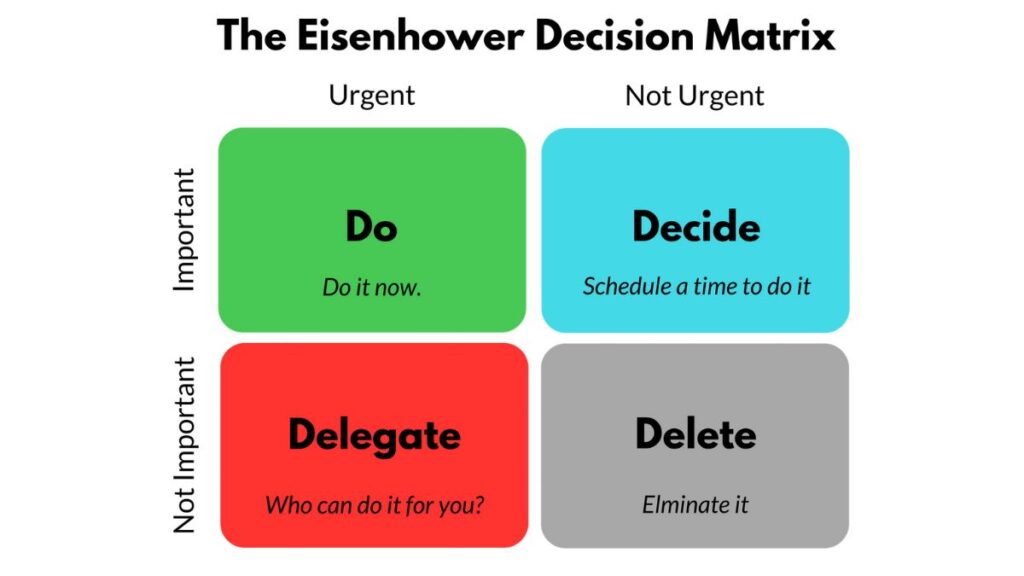
The Eisenhower Matrix is a strategic time management tool that helps prioritize tasks by urgency and importance, leading to more effective decision-making and task management. This method divides tasks into four quadrants based on two criteria: whether they are important and whether they are urgent. The matrix is a cornerstone technique among our specially curated time management strategies, enabling individuals to visually categorize and tackle their tasks in a manner that aligns with their priorities and deadlines.
To adopt the Eisenhower Matrix, follow these step-by-step instructions:
- Understand the Quadrants: Familiarize yourself with the four quadrants of the Eisenhower Matrix:
- Quadrant 1 (Do First): Tasks that are both urgent and important. These tasks require immediate attention and action.
- Quadrant 2 (Schedule): Tasks that are important but not urgent. These should be scheduled for later but are crucial for achieving long-term goals.
- Quadrant 3 (Delegate): Tasks that are urgent but not important. Whenever possible, these should be delegated to others.
- Quadrant 4 (Eliminate): Tasks that are neither urgent nor important. These should be minimized or eliminated.
- List Your Tasks: Write down all the tasks you need to accomplish. Don’t worry about their order or priority at this stage.
- Categorize Each Task: Assign each task to one of the four quadrants based on its urgency and importance. Be honest with yourself about which tasks truly deserve your immediate attention and which can be scheduled, delegated, or eliminated.
- Take Action on Quadrant 1: Focus on completing tasks in Quadrant 1 first. These are your top priorities that need immediate attention.
- Plan for Quadrant 2: Schedule time to work on tasks in Quadrant 2. These are crucial for your personal and professional growth and should be given dedicated time in your schedule.
- Delegate Quadrant 3 Tasks: Identify tasks in Quadrant 3 that can be delegated to others. This will free up your time to focus on more important tasks.
- Eliminate or Limit Quadrant 4 Activities: Critically assess tasks in Quadrant 4 and eliminate them if they offer little to no value. This might include unnecessary meetings, time-consuming emails, or habitual time-wasters.
- Review and Adjust Regularly: Your priorities and tasks will change over time. Regularly review and adjust your matrix to reflect your current priorities and deadlines.
- Make It a Habit: Incorporate the Eisenhower Matrix into your daily planning routine. Over time, this will help you become more efficient at prioritizing tasks and managing your time.
Adopting the Eisenhower Matrix allows for a clear visualization of where to focus your efforts and time. By distinguishing between urgency and importance, you can allocate your resources more effectively, leading to increased productivity and stress reduction.
ALSO READ | Simple Methods to Teach Children to Value Money
6. Getting Things Done (GTD)
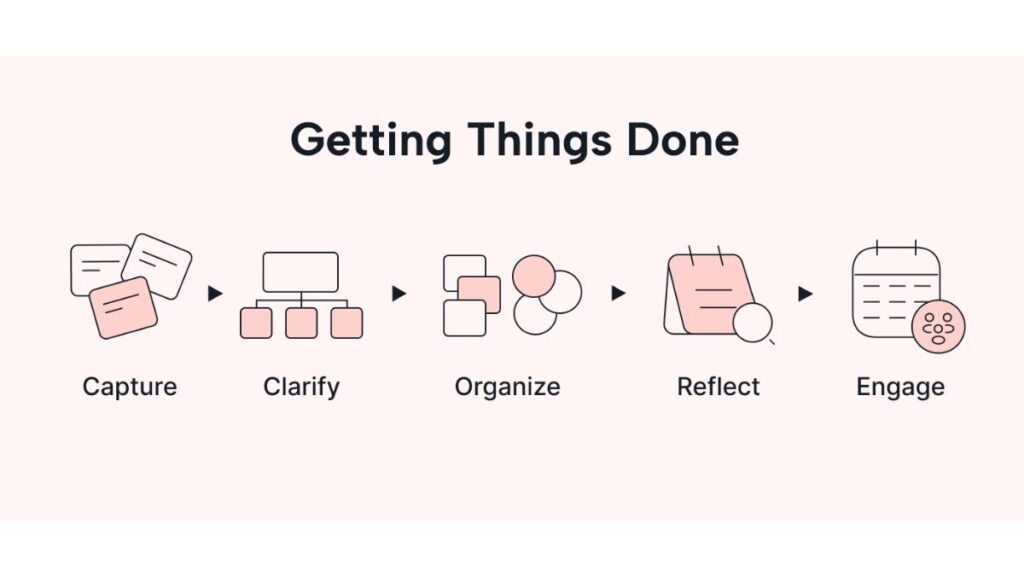
Getting Things Done (GTD) is a comprehensive time management method that helps individuals organize and prioritize their tasks and projects efficiently. Developed by David Allen, this technique is centered around the idea of moving planned tasks and projects out of the mind by recording them externally and then breaking them into actionable work items. This process allows individuals to focus on executing tasks without the distraction of remembering them, leading to increased productivity and mental clarity.
To adopt the Getting Things Done (GTD) method, follow these steps:
- Capture Everything: Collect all tasks, ideas, projects, and actionable items from your mind and external sources into a single, trusted system. Use an inbox, digital tool, or notebook to ensure nothing is forgotten.
- Clarify the Tasks: Process what each item means. Decide if an item is actionable. If not, discard it, put it on hold, or file it as reference. If it is actionable, determine the next action step and the project it belongs to, if applicable.
- Organize: Place each item in the appropriate category. Use lists for different contexts, such as projects, next actions, waiting for (tasks that depend on someone else), and someday/maybe (ideas or tasks for the future).
- Reflect: Regularly review and update your lists. Daily reviews help manage your next actions, while weekly reviews provide a higher perspective to ensure your work aligns with your goals and responsibilities.
- Engage: Choose your next actions based on context, available time, energy levels, and priorities. Focus on executing these tasks, relying on your system to guide your daily work and decision-making process.
- Define Projects: Identify any commitments or goals that require multiple steps to complete and track them as projects. Regularly review these projects to determine the next actions required to move them forward.
- Use a Tickler File: Implement a 43-folder system (12 monthly and 31 daily) to organize documents and information you need at specific times.
- Practice the Two-Minute Rule: If an action can be completed in two minutes or less, do it immediately. This prevents small tasks from accumulating.
- Establish a Waiting For List: Keep track of tasks that depend on external parties, ensuring nothing falls through the cracks.
- Maintain a Someday/Maybe List: Capture ideas and projects you’re not ready to start but want to come back to in the future.
Adopting GTD involves setting up a system that suits your personal and professional life, allowing you to manage your tasks and responsibilities effectively. By externalizing your tasks and breaking them down into actionable steps, you can focus on getting things done without the mental clutter of trying to remember everything.
7. Pickle Jar Theory

The Pickle Jar Theory is a vivid metaphor for time management and prioritization that illustrates the importance of tackling major tasks and priorities first before filling one’s schedule with less critical activities. This theory compares the finite capacity of our time and attention to a pickle jar, where rocks, pebbles, sand, and water represent different types of tasks and commitments in our lives. The key message is that if you start with the smaller items (sand and water), you won’t have space for the larger, more important ones (rocks).
Here’s how to adopt the Pickle Jar Theory in your time management approach:
- Identify Your “Rocks”: These are your most significant tasks, goals, and priorities that will have the most substantial impact on your life or work. They should be addressed first in your planning.
- Recognize Your “Pebbles”: These tasks are important but not as critical as your rocks. They represent smaller goals and responsibilities that need to be accomplished but are secondary to your main priorities.
- Acknowledge Your “Sand”: This category includes everyday tasks and errands that are less important and should only be fitted in after your rocks and pebbles. These can often be the small distractions or minor tasks that consume time but don’t contribute significantly towards achieving your larger goals.
- Consider Your “Water”: Water represents the remaining filler of your time—leisure activities, relaxation, and socializing. These are also necessary for a balanced life but should come after all your tasks have been prioritized and scheduled.
- Plan With Your Jar in Mind: When planning your day or week, start by scheduling your rocks, then your pebbles, followed by sand, and finally, if there’s space, add water. This ensures that you prioritize and accomplish your most important tasks.
- Review and Adjust Regularly: Regularly assess your jar to ensure you’re focusing on the right priorities. Life changes, and so will your rocks, pebbles, sand, and water. Be flexible and willing to adjust your priorities as needed.
- Use Visualization: Sometimes physically using a jar with actual rocks, pebbles, sand, and water can be a powerful visual aid and reminder of how to effectively prioritize your time and tasks.
Adopting the Pickle Jar Theory can lead to more mindful and effective time management, ensuring that you focus on what truly matters most before allowing lesser priorities to consume your valuable time and energy.
8. Task Batching Technique
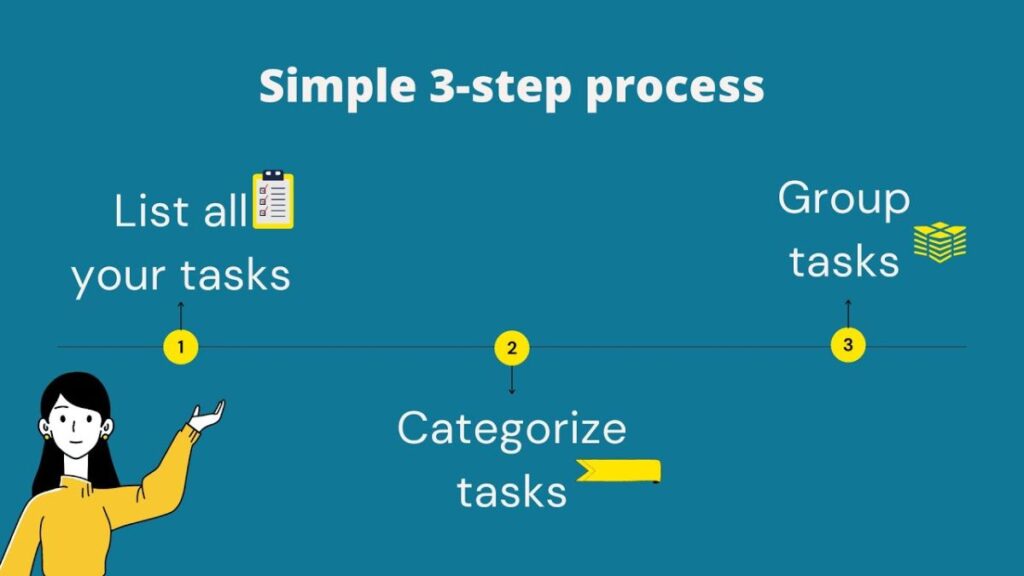
The Task Batching Technique is a highly efficient time management strategy that involves grouping similar tasks together and tackling them in a designated block of time, rather than scattering them throughout the day. This approach minimizes the mental load and time lost in transitioning between different types of tasks, leading to increased productivity and focus. By dedicating specific times to batched tasks, individuals can reduce interruptions, enhance focus, and achieve a higher level of efficiency.
Here’s how to implement the Task Batching Technique effectively:
- Identify Batchable Tasks: Review your task list and identify tasks that are similar in nature or require a similar mindset or resources. Common categories include email, phone calls, content creation, administrative tasks, and meetings.
- Organize Tasks into Batches: Group the identified tasks into batches based on their similarity. Each batch should consist of tasks that can be logically completed together within a block of time.
- Schedule Time Blocks: Allocate specific blocks of time in your schedule to tackle each batch of tasks. The length of these blocks can vary based on the nature of the tasks and your personal productivity rhythms. Consider your most productive times of the day for the most challenging batches.
- Minimize Distractions: During each time block, eliminate potential distractions to maintain focus on the batch at hand. This might involve turning off notifications, closing unrelated applications, or informing colleagues of your focused work period.
- Practice Discipline: Stick to your scheduled time blocks as strictly as possible. It can be tempting to switch tasks or extend time blocks, but maintaining discipline is key to the effectiveness of task batching.
- Adjust as Needed: After trying task batching for a while, review your productivity and the quality of your work. Adjust your batches and time blocks as necessary to find the most effective arrangement for your tasks and working style.
- Incorporate Breaks: Ensure that you schedule short breaks between your time blocks to rest and recharge. This helps maintain high levels of energy and focus throughout your batching sessions.
- Use Tools and Apps: Consider using time management tools or apps to help you schedule, time, and monitor your task batches. These can assist in keeping you on track and analyzing your productivity patterns.
Adopting the Task Batching Technique allows for a structured approach to managing a wide array of tasks, leveraging focused work periods for similar tasks to maximize efficiency and productivity.
Summary
In summary, we’ve delved into eight distinct time management techniques, chosen for their straightforward implementation and proven ability to enhance task prioritization. This curated list is the result of thorough research among various organizations and individuals who have witnessed tangible improvements in their productivity and time management by adopting these methods. As we conclude, we encourage you to incorporate these strategies into your daily routine. By doing so, you’ll not only boost your productivity but also ensure you have ample time to enjoy life to its fullest. Embrace these techniques and start living more fully and efficiently.







